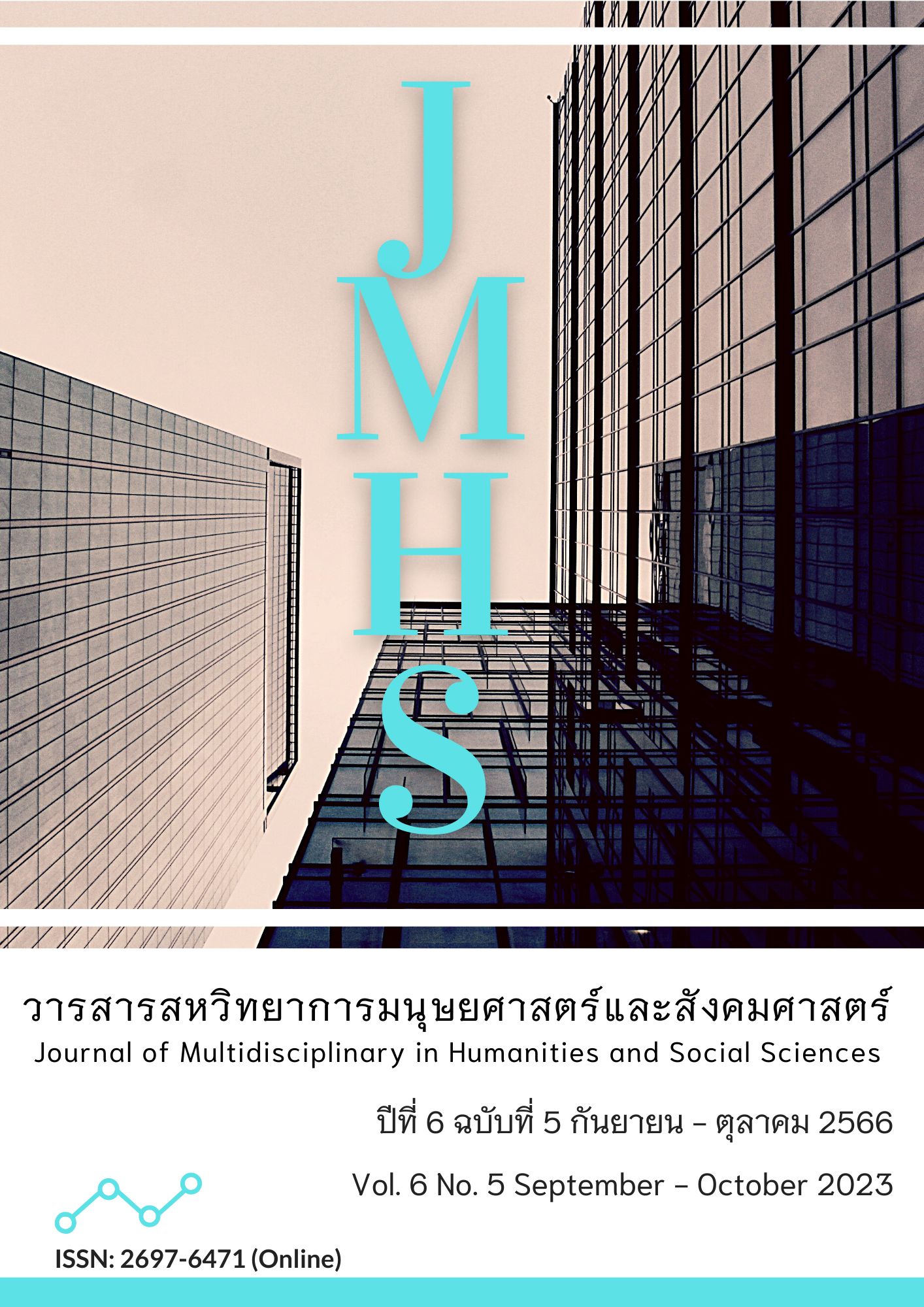Causal Factors Influencing Decision to Read Comics via Line Webtoon Application in Bangkok and Its Vicinity
Main Article Content
Abstract
The article aimed to 1) develop and validate the consistency of a causal relationship model decision to read comics via Line webtoon application in Bangkok and its vicinity; and 2) study causal factors influencing read comics via Line webtoon application in Bangkok and its vicinity. This study was quantitative research. The sample consisted of people who have read comics via the Line webtoon application in Bangkok and its vicinity (280 people) by convenience sampling. The tools used in the research were online questionnaires. The statistics used in data analysis were frequency, percentage, confirmatory factor analysis, and structural equation model.
The results of this research were the development of the causal relationship models, which consisted of four components: 1) electronic word-of-mouth; 2) brand image; 3) trust; and 4) decision to read. The model was consistent with the empirical data to a great extent. The statistic showed the CMIN = 190.19, df = 136, CMIN/df = 1.40, GFI = 0.93, AGFI = 0.90, SRMR = 0.04, RMSEA = 0.03. The final prediction coefficient was 0.90, indicating that the variables in the model can explain the variance of the decision to read comics via the Line webtoon application by 90 percent. It was found that the brand image was the most influential factor in the decision to read comic books via the Line webtoon application, and the artist should consider creating the image of the cartoon and themselves to create a good electronic word-of-mouth trend and the decision to read comics in the future.
Article Details

This work is licensed under a Creative Commons Attribution-NonCommercial-NoDerivatives 4.0 International License.
Views and opinions appearing in the Journal it is the responsibility of the author of the article, and does not constitute the view and responsibility of the editorial team.
References
ดารินทร์ จิตสุวรรณ. (2561). อิทธิพลของการสื่อสารปากต่อปากแบบอิเล็กทรอนิกส์ต่อความตั้งใจเลือกใช้บริการโรงแรมที่พักในประเทศไทย. วารสารระบบสารสนเทศด้านธุรกิจ, 4(1), 22-23. สืบค้นจาก https://so02.tci-thaijo.org/index.php/mbs/article/download/251017/175187/1003 396
เดชา พละเลิศ, ธาตรี จันทรโคลิกา, กอบกูบ จันทรโคลิกา, พาลน์ ทีฆทรัพย์, ศุภวัฒน์ สุขประเมษฐ์, และ เกษรา กาญจนภูมิ. (2566). บทบาทของกิจกรรมการตลาดที่ยั่งยืนส่งผลต่อความผูกพันกับตราสินค้าของผู้บริโภคที่ใช้รถยนต์อีโคคาร์ในเขตกรุงเทพมหานคร. วารสารการพัฒนาทรัพยากรมนุษย์และองค์การ, 15(1), 180-200. สืบค้นจาก https://so01.tci-thaijo.org/index.php/EAUHJSocSci/article/view/67168
ปวริศา ศรีสิริ, และบุญญาดา นาสมบูรณ์. (2565). ภาพลักษณ์และคุณค่าของตราสินค้าส่งออกภูมิภาคฮอกไกโดส่งผลต่อการตัดสินใจตัดสินใจซื้อสินค้าจากภูมิภาคฮอกไกโดในประเทศไทย. วารสารบริหารธุรกิตและภาษา, 10(2), 36-45. สืบค้นจาก https://so06.tci-thaijo.org/index. php/TNIJournalBA/article/view/256095
ธัชกร หาญกิติวัธน์, วิศนันท์ อุปรมัย, และเสาวภา มีถาวรกุล. (2565). การสื่อสารการตลาดแบบดิจิทัลที่มีอิทธิพลต่อกระบวนการตัดสินใจเลือกใช้บริการร้านอาหารที่มีสาขาในห้างสรรพสินค้า เขตกรุงเทพมหานคร. วารสารดิจิทัล ธุรกิจ และสังคมศาสตร์. 8(2), 3-12.สืบค้นจาก https://rsujournals.rsu.ac.th/index.php/jdbs/article/view/2664
ธัญลักษณ์ สุมนานุสรณ์. (2562). พฤติกรรมการตัดสินใจซื้อสินค้าผ่านเครือข่ายสังคมออนไลน์ของผู้สูงอายุกลุ่มเบบี้ บูมเมอร์, วารสารวิทยาการจัดการ มหาวิทยาลัยราชภัฏนครปฐม, 6(2), 175-188. สืบค้นจาก https://so03.tci-thaijo.org/index.php/JMSNPRU/article/view/232413
นันทินี บุญยปรารภชัย และ ประพล เปรมทองสุข. (2566). โมเดลความสัมพันธ์เชิงสาเหตุของปัจจัยที่ส่งผลให้เกิดความตั้งใจซื้อสินค้าออนไลน์ของผู้บริโภคเจเนอเรชั่นเบบี้บูมเมอร์และเจเนอเรชั่นเอ็กซ์ เขตกรุงเทพมหานครและปริมณฑล. วารสารนวัตกรรมการจัดการศึกษาและการวิจัย, 5(1), 85-100. สืบค้นจาก https://so02.tci-thaijo.org/index.php/jemri/article/view/258865
พิชามญชุ์ เลิศวัฒนพรชัย, พงษ์สันติ์ ตันหยง, ผ่องใส สินธุสกุล. (2566). ปัจจัยที่มีอิทธิพลต่อการตัดสินใจใช้บริการสั่งอาหารแบบเดลิเวอรี่ผ่านสื่ออิเล็กทรอนิกส์ในจังหวัดนครปฐม. วารสารสหวิทยาการมนุษยศาสตร์และสังคมศาสตร์, 6(1), 141-156. สืบค้นจาก https://so04.tci-thaijo.org/index.php/jmhs1_s/article/view/261641
พีรวัส ปทุมุต์ตรังษี, จรูญ ชำนาญไพร และ เบญจฐา วัฒนกุล. (2566). การยอมรับเทคโนโลยีที่มีผลต่อการตัดสินใจซื้อสินค้าออนไลน์ของวัยรุ่น ในอำเภอปากเกร็ด จังหวัดนนทบุรี. วารสารนวัตกรรมการจัดการศึกษาและการวิจัย, 5(1), 49-60. สืบค้นจาก https://so02.tci-thaijo.org/ index.php/jemri/article/view/258588
วิชชุณีย์ ภูวดลกิจ และ ณัฏฐ์ชุดา วิจิตรจามรี. (2564). การสร้างความหมายและการรับรู้ภาพลักษณ์ของสินค้าแบรนด์หรูของผู้บริโภค Generation Z. วารสารมหาจุฬานาครทรรศน์, 8(4), 306-315. สืบค้นจาก https://so03.tci-thaijo.org/index.php/JMND/article/download/251653/16864 4/894008
วรพจน์ วงศ์กิจรุ่งเรือง. (2561). ทักษะดิจิทัลก้าวสู่พลเมืองในศตวรรษที่ 21. สืบค้นเมื่อ 25 ธันวาคม 2564, จาก https://ops.go.th/main/index.php/aboutus/history/1355-goto-citizens21st.html
วลีรัตน์ นันทเอกพงศ์ และ สายพิณ ปั้นทอง. (2565). ปัจจัยที่มีอิทธิพลต่อการตัดสินใจซื้อผลิตภัณฑ์เสริมอาหารเพื่อสุขภาพของคนวัยทำงาน จากร้านสะดวกซื้อในกรุงเทพมหานคร. วารสารนวัตกรรมและการจัดการ, 7(1), 96-109. สืบค้นจาก https://so03.tci-thaijo.org/index.php/journalcim/article/view/259382
สำนักงานสถิติแห่งชาติ. (2561). เกิน 8 บรรทัดแล้วนะ!! ผลสำรวจการอ่านปี 61 ชี้คนไทยอ่านเพิ่มเฉลี่ย 80 นาทีต่อวัน, สืบค้นเมื่อ 6 พฤศจิกายน 2465, จาก https://www.marketingoops.com/report/read-thai-people/
ไอริสสญ์ เจนอารีวงศ์ และ เกตุวดี สมบูรณ์ทวี. (2565). ผลกระทบของภาพลักษณ์ตราสินค้าส่งผลต่อการตัดสินใจซื้อผลิตภัณฑ์เชิงประสบการณ์ ในมุมมองของผู้บริโภคชาวไทย. วารสารเกษตรศาสตร์กิจประยุกต์, 16(24), 49-72. สืบค้นจาก https://so04.tcithaijo.org/index.php/KAB/article/view/254323
อัศนีย์ ณ น่าน และ ศศิชา วงศ์ไชย. (2564). ความสัมพันธ์ระหว่างการสื่อสารแบบปากต่อปากทางอิเล็กทรอนิกส์ (e-WOM) และพฤติกรรมในการเลือกใช้บริการสั่งอาหารผ่านแอปพลิเคชันของผู้บริโภคในจังหวัดลำปาง. วารสารวิจัยมหาวิทยาลัยเวสเทิร์น มนุษยศาสตร์และสังคมศาสตร์, 7(1), 263-273. สืบค้นจาก https://so04.tci-thaijo.org/index.php/WTURJ/article/view/259842
Allen, I. E., & Seaman, C. A. (2007). Likert Scale and Data Analyes. Statisic Roundtable, 65-66. Retrieved from https://www.bayviewanalytics.com/reports/asq/likert-scales-and-data-analyses.pdf
Chuayounan, S. (2022). The Causal Relationship Model of The Happiness of the Working Elderly within Career Groups. International Journal of Multidisciplinary in Management and Tourism, 6(1), 18–32. https://doi.org/10.14456/ijmmt.2022.3
Joreskog, K. G., & Sorbom, D. (1984). Advances in Factor Analysis and Structural Equation Models. Lanham: Rowman & Littlefield.
Hair, J. F., Hult, G. T. M., Ringle, C. M., & Sarstedt, M. (2014). A Primer on Partial Least Squares Structural Equation Modeling (PLS-SEM). California: Sage.
Hair, J. F., Black, W. C., Babin, B. J. & Anderson, R. E. (2010). Multivariate Data Analysis. (7th ed.). New Jersey: Prentice Hall.
Hoelter, J. W. (1983). The Effects of Role Evaluation and Commitment on Identity Salience. Social Psychology Quarterly, 46(2), 140–147. https://doi.org/10.2307/3033850
Hu, L. T., & Bentler, P. M. (1999). Cutoff Criteria for Fit Indexes in Covariance Structure Analysis: Conventional Criteria Versus New Alternatives. Structural Equation Modeling, 6(1), 1–55. https://doi.org/10.1080/10705519909540118
Kline, R. B. (2011). Principles and Practices of Structural Equation Modeling. (3rd ed.). New York: The Guilford.
Mulcahy, R., Letheren, K., McAndrew, R., Glavas, C., & Russell-Bennett, R. (2019). Are households ready to engage with smart home technology?. Journal of Marketing Management, 35(15-16), 1370-1400. Retrieved from https://www.tandfonline.com/journals/rjmm20
Schreiber, J. B., Stage, F. K., King, J., Nora, A., & Barlow, E. A. (2006). Reporting Structural Equation Modeling and Confirmatory Factor Analysis Results: A Review. The Journal of Educational Research, 99(6), 323–337. https://doi.org/10.3200/JOER.99.6.323-338
Schumacker, R. E., & Lomax, R. G. (2004). A Beginner's Guide to Structural Equation Modeling. (2nd ed.). New Jersey: Lawrence Erlbaum Associates.
Schumacker, R. E., & Lomax, R. G. (2010). A Beginner’s Guide to Structural Equation Modeling. (3rd ed.). Oxfordshire: Routledge.
Stefanny, N., Rahmiat, F., & Roni, M., (2022). The Role of Brand Image and Brand Trust in Mediating the Influence of e-WOM on Purchase Decision (Case of Video-On-Demand Netflix). Journal of Management and Technology, 2(1), 12-21. http://dx.doi.org/10.33021/ideas.v2i1.3696
Ullman, M. T. (2001). The Declarative/Procedural Model of Lexicon and Grammar. Journal of Psycholinguistic Research, 30(1), 37–69. https://doi.org/10.1023/A:1005204207369
Zou, Z., & Cheng-Jui, T. (2022). Research on New Media Marketing of Credit Card Business.
International Journal of Multidisciplinary in Management and Tourism, 6(2), 197–226. https://doi.org/10.14456/ijmmt.2022.16


